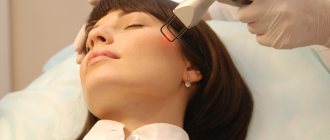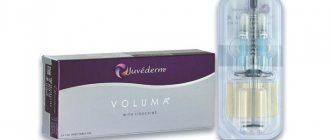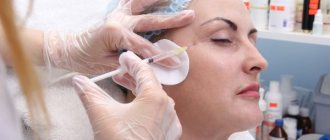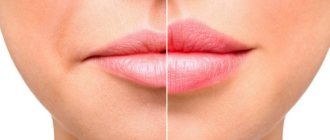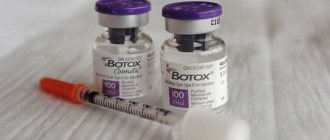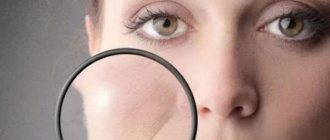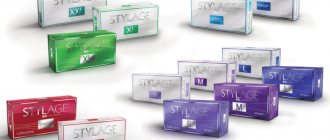Fillers are gel-like preparations that serve as a filler for cosmetic injections.
Before the procedure for cosmetic injection of hyaluronic acid into the skin, it is important to know about the procedure itself and contraindications. At an appointment with a cosmetologist, many people discuss the topic of alcohol: whether fillers and alcohol are combined, whether it is possible to drink alcohol before or after a facial correction procedure or whether it is strictly prohibited. The position of cosmetologists on this issue is clear: it would be better to play it safe against any complications and strictly prohibit the patient from drinking alcohol. However, such categoricalness is not always necessary.
People who are addicted to intoxicating drinks most likely know very well: it is largely because of this destructive passion that the need to go to a cosmetologist arises. And it occurs much earlier than in non-drinkers. Alcohol disrupts the natural synthesis of hyaluronic acid, and interventions have to be resorted to. Even one glass of wine harms the skin, causes dehydration and swelling, provokes early aging and the appearance of early wrinkles. So, to preserve youth and beauty of the skin, it is better to give up this habit for good, because ethanol is harmful to the skin, whether fillers are injected into it or not.
Leather and alcohol
Often one glance at a person is enough to determine his addiction to alcohol. A number of functions are seriously impaired under the influence of ethanol. Alcohol, dissolving in biological fluids, washes away beneficial substances and water from the body, disrupting the structure of cell membranes and metabolic processes inside cells. The resulting dehydration in the tissues is reflected on the skin as follows:
- malfunctions of the liver cause skin rashes of various locations and changes in complexion;
- inhibition of the secretion of hormonal glands entails serious changes in its structure, the roughness and swelling of the skin increases, the pores increase, which in appearance resembles the surface of a strawberry;
- sleep disturbances caused by drinking alcohol lead to the appearance of dark circles under the eyes;
- the subcutaneous fat layer with the toxins accumulated in it becomes heterogeneous, and a lumpy skin texture appears. Alcohol is included in lipid metabolism, changing the structure of adipose tissue cells, hence their unevenness in volume and shape;
- ethanol thins the walls of blood vessels, causing them to expand, this leads to noticeable “stars” on the face, and in addition, alcohol dehydrates the skin, thins its layers, the vessels become closer to the surface of the epidermis and begin to appear through it;
- improper distribution of fluid, incoming oxygen, the presence of toxins and hormonal disorders in their combination lead to loss of skin elasticity, the appearance of wrinkles, the chin, skin around the eyes, cheeks sag due to inhibition of the synthesis of its own collagen and elastin.
You can also add to this list the specific facial expressions of a drunk person, the wrinkles from which remain on the face like a brand.
There are simply no positive aspects of drinking alcohol. The human body is initially complete and does not require alcohol doping.
What are fillers and their side effects?
A filler is a gel-like preparation that, due to its consistency and interaction with body tissues, creates a filling effect under the skin. By introducing such drugs, the specialist achieves the filling of anatomical voids, first of all, increasing the volume of the lips, cheekbones, softening the jawline, smoothing out small wrinkles and folds, and correcting the shape of the nose. At the same time, such drugs have the effect of rejuvenating the skin, which cannot but please beauty guardians.
There are three conditional groups of side effects from appearance correction procedures:
- Individual sensitivity to drugs is the most common problem in cosmetology. An indispensable stage of preparation is to carry out a test on the skin for intolerance to the product: if there is an allergic reaction, the procedure is prohibited.
- Local reactions due to irritating manipulations. The appearance of slight swelling and pain during the administration of drugs is absolutely normal and, with proper care, all bruises and redness will certainly disappear.
- All other reactions associated with a violation of the technique and/or technology of filler injection. The procedure must be carried out under sterile conditions, the material is carefully selected, and all manufacturer’s instructions are followed. The office must have antihistamines and enzymes that neutralize the effect of the filler. You should first consult with a specialist, since the presence of infections in the body can lead to complications. Of course, a qualified specialist is also interested in a positive result, and by following all the necessary measures, he will reduce the risk of infection to the patient.
Removing the consequences of poor-quality appearance correction also requires compliance with certain conditions. Special enzymes are introduced into the location of the filler to speed up the dissolution process of the drug. Sometimes dissection of scar tissue and organization of drainage are required.
The depth of filler injection also plays an important role. With intramuscular injection of the drug, facial expressions may be disrupted due to rupture of fibers in the muscles. The resulting cicatricial induration and swelling are painful. If the drug is injected too close to the surface of the skin, then a number of unpleasant consequences occur. First of all, you can notice whitish bubbles under the skin - this is how the filler itself is visible under a thin layer of skin. A puncture is made at the site of the unsuccessfully administered drug and the liquid is released. Severe itching and tissue inflammation may also occur, which will require taking corticosteroid medications.
Reasons for incompatibility
It is necessary to clearly understand the reasons why you should not drink certain drinks, as they say, stronger than kefir.
This is due to the fact that due to dilated blood vessels due to alcohol intake, the drug may not be completely absorbed and the injections will have to be repeated again and again. In addition, after injections, slight swelling and bruising already occurs, and if you also drink “hot” drinks, this will only cause additional swelling on the face and body.
Therefore, instead of the required 2-3 days, the treated area will take at least 7-10 days to heal. Especially if this concerns, for example, the lip augmentation procedure - its negative consequence after drinking alcohol can be their asymmetry.
Remember: the compatibility of wine, vodka, cognac and hyaluronic acid is extremely poor!
Fillers based on hyaluronic acid
Biorevitalization, or the introduction of hyaluronic acid-based fillers under the skin, has a number of advantages. First of all, hyaluronic acid is naturally produced by the body, helps keep the skin moisturized and preserves the microtexture of the skin, and the introduction of exohyaluronic acid stimulates not only the synthesis of its own, but also the synthesis of collagen and elastin, which make the skin elastic and strong.
An unpleasant aspect of using hyaluronic fillers is the risk of allergic reactions. Moreover, such consequences can occur both after a short period of time and after several years. The development of oncological formations or erythema is possible.
When treating negative reactions, the enzyme hyaluronidase and hormonal drugs are mainly used.
The most problematic are the wrinkles that run from the wings of the nose to the corners of the lips. They are the most noticeable and difficult to eliminate. But photos showing nasolabial lips before and after fillers show that nothing is impossible.
To get rid of nasolabial folds, cosmetologists use fillers. These are dense gels that add missing volume and smooth out wrinkles. Unlike plastic surgery, the procedure is performed through injections and eliminates surgery. This reduces the risk of complications and shortens the duration of the rehabilitation period several times.
Contour plastic surgery with fillers can be combined with other procedures, for example, botulinum therapy. This aspect is relevant for older women, for whom hyaluronic acid is no longer enough to achieve results.
Before introducing fillers into the nasolabial area, you should consult with a cosmetologist. He will tell you what to do to avoid side effects and how to prepare for injections. Fillers can be injected no earlier than 2 weeks after peeling, laser resurfacing and other procedures involving effects on the deep and middle layers of the skin.
3-4 days before the introduction of hyaluronic acid, it is necessary to exclude:
- taking antibiotics and drugs that affect blood clotting;
- alcohol consumption (the rule applies not only to strong alcoholic drinks, but also to beer);
- thermal effects on the face (visiting a bathhouse, sauna, solarium, prolonged exposure to the sun);
- face massage;
- strength physical activity.
Smokers need to reduce the number of cigarettes to a minimum. Nicotine can destroy hyaluron, promote nervous tension and vasospasm, which leads to unpleasant consequences during and after the procedure (pain, the appearance of compactions and bruises, swelling).
In reviews of nasolabial surgery before and after fillers, patients often mention that the procedure does not hurt, only slight discomfort is felt. This is achieved through the use of very thin needles, preliminary anesthesia and the presence of anesthetic in the fillers.
The drug is administered in several stages:
- Selection of the type of drug (by manufacturer, density), calculation of its quantity. At this stage, the condition of the skin is studied and it is determined how deeply to inject the filler.
- Anesthesia. It is carried out using local creams and gels, less often - injections of anesthetic.
- Introduction of filler. The cosmetologist makes 2-3 injections into each nasolabial fold.
- Gel distribution. After injection, the filler should be evenly distributed over the wrinkles. This is done with massaging movements. The patient may notice discomfort, but it will not hurt him.
- Disinfection. At the last stage, the protruding drops of blood are removed and the skin is cleansed.
All actions take about 20-40 minutes. After the procedure, the cosmetologist will give recommendations for further care to avoid an unsuccessful result and not complicate the recovery period.
For injections, syringes with very thin needles or cannulas are used. When it comes to fillers, there are several options. Natural-based gels are common. To fill the nasolabial lips, preparations based on hyaluronic acid are most often used. This substance is safe as it is found in body tissues.
Hyaluronic acid accumulates and retains moisture, promotes the production of collagen and elastin. Under its influence, wrinkles quickly smooth out, and if they begin to appear again, they will not be so deep.
The material is biodegradable and is eliminated from the body over time. The lower limit is 8 months, the upper limit is 1.5 years. The rate of removal depends on individual parameters, including age, initial skin condition, and the activity of enzymes that are produced to dissolve natural hyaluronic acid. After the effect disappears, the woman needs to come for correction.
The most popular preparations with hyaluronic acid are Juvederm, Perlane, Restylane.
Products with other active ingredients are rarely used to remove nasolabial folds. These can be gels with calcium hydroxyapatite. The compound stimulates the body to produce its own collagen. An example of such a gel is Radiesse. The effect after its administration lasts up to two years.
Despite the safety of the procedure, filling the nasolabial area with fillers has a number of contraindications. These include:
- hypersensitivity to the components of the drug;
- pregnancy and lactation;
- diabetes;
- acute stage of herpes;
- ARVI;
- infectious diseases;
- heat;
- inflammatory processes and wounds in the area of filler injection;
- oncological diseases;
- exacerbation of chronic diseases;
- mental disorders;
- diseases associated with blood clotting;
- tendency to form scars;
- autoimmune pathologies.
Also, cosmetologists do not recommend coming for the procedure during menstruation. During this period, the risk of swelling and bruising after injections increases.
To look younger, it is not enough to inject fillers regularly. The effectiveness of the procedure, regardless of the patient’s age, is achieved by a combination of injections and compliance with the rules of care during rehabilitation.
- For the first 6-8 hours after beauty injections, it is forbidden to apply cold or hot compresses to the area where the gel was introduced, visit the sauna or go out into the cold, take a horizontal position, wash your face, rub your face, use cosmetics, actively use facial expressions with a smile and conversations.
- You cannot sunbathe, play sports, or take a bath for 3-4 days after the procedure.
- It is forbidden to drink hot drinks or drink alcohol for 7-14 days. For the same period, it is better to give up cigarettes or minimize their number.
- Maintain adequate fluid intake and avoid dehydration.
- If hematomas and other negative symptoms do not go away for a long time, consult a cosmetologist. Adverse reactions can be eliminated only with special-purpose ointments.
Failure to follow the rules will lead to the destruction of hyaluronic acid and deformation of the filler. As a result, creases, bumps that are puffy and hard to the touch, and hematomas may appear.
Reviews about nasolabial fillers are in most cases positive. Women claim that changes for the better are noticeable already in the cosmetologist’s office. The maximum effect appears within two weeks after the swelling has gone down and the puncture sites have healed. Nasolabial lips after fillers in the before and after photos are a clear confirmation of the patients’ words.
Negative reviews are rare. They talk about the painfulness of the procedure and the protracted recovery period. The reason for this could be non-compliance with the technique of administering the drug, individual intolerance to its components, or ignoring the recommendations of a cosmetologist.
Collagen
The main ones are products based on bovine and human collagen. Modern drugs cause allergic reactions much less often due to the highly purified components. In addition, many gels are supplemented with substances that stimulate the production of tissues’ own collagen.
But the risk of immune resistance of the body, the development of granulomatosis in tissues and inflammation after the introduction of collagen fillers is still high. The cosmetic effect of such drugs is short-term.
Possible negative reactions from fillers when combined with alcohol
People who are addicted to alcohol and want to rejuvenate themselves with fillers should know: ethanol will reduce the positive effect of the procedure many times over. The active ingredient simply won't work. The shape of the lips will remain the same. Nasolabial folds will not straighten out. In other words, there will either be no positive results at all or they will manifest themselves minimally.
At the same time, there will be a high risk of dangerous things appearing in the form of:
- tumor formation;
- development of inflammation;
- the occurrence of lip asymmetry;
- hematomas in the injection area;
- manifestations of an allergic nature;
- development of inflammatory processes and gel rejection;
- preservation of the result for a short period;
- need to repeat the injections soon.
Poly-L-lactic acid fillers
Injectable preparations based on poly-L-lactic acid, or PLLA, are stimulants for the production of its own framework of collagen and hyaluronic fibers. Initially, this substance proved effective in treating atrophy of the subcutaneous fat layer in HIV-infected people. The effect of such drugs lasts for a long period and appears gradually. Due to the fact that the process of formation of subcutaneous tissue after filler injection is difficult to predict, it is not recommended to use it to add volume to the lips, and PLLA products are less popular in cosmetology.
The risk of nodules and allergic reactions in the corrected area is minimized.
Human factor
Unfortunately, there is no escape from this. It would not be superfluous to remind you that the injections must be carried out by a doctor who has all the documents and certificates confirming his education and specialization. This can be either a plastic surgeon or a cosmetologist.
Explains clearly and looks good. 7 signs of a competent cosmetologist Read more
Alcohol before filler injections
Carrying out appearance correction procedures in the presence of ethanol in the blood can lead to serious protracted reactions. Blood coagulation and healing of microtraumas in tissues may be disrupted. In addition, due to dilation of blood vessels and swelling of the skin, the location and volume of the filler is perceived distortedly. If there is a need for contour plastic surgery, you should take it calmly, this will minimize all risks.
The doctor will refuse to perform the procedure on the patient if he sees signs of alcohol consumption.
Carrying out the procedure
There is a type of mesotherapy called biorevitalization. It involves injecting the drug into the deeper layers of the skin on the face. The decision to choose a procedure is made by a specialist based on the client’s existing problems and wishes.
Previously, needles in a contour plastic sheath were used to introduce stabilized hyaluronic acid. Today they have been replaced by microcannulas. The density of fillers may vary. To model the face, a composition characterized by high and medium density is used.
Through such cosmetology sessions:
- improve the oval of the face;
- correction of eyebrows, eyelids, cheekbones, cheeks, chin;
- eliminate ptosis of soft tissues.
In some situations, possible complications are so dangerous that mesotherapy is simply prohibited.
A patient's history of thrombocytopathy, herpes in the acute phase, diabetes, pathologies of an autoimmune and oncological nature, foci of inflammation, skin damage, fever, allergic reactions to the components of the injection composition, hypertrophic and keloid scars is a contraindication to the procedure.
How does alcohol interact with hyaluronic acid?
Alcohol consumption, even in small doses, entails a number of changes that indirectly affect the result of contouring:
- inhibition of nerve cells by ethanol reduces the body’s sensitivity and distorts the perception of one’s own sensations during the procedure;
- behavioral looseness and absent-minded attention to the doctor’s instructions;
- indifference and negligence towards one’s own health and towards the doctor;
- dilated blood vessels and forced blood circulation relax muscle tissue;
- excessive swelling of tissues and specific facial expressions.
Factors that directly influence the outcome of cosmetic procedures are the reactions of alcohol on the body and the interaction of alcohol molecules with the filler material.
- alcohol toxins disrupt the permeability of the vascular wall, causing pathological effusions in the tissue, which means there is a possibility of improper distribution of the gel under the skin;
- alcohol reacts with vitamin complexes, destroying their structure, therefore, part of the gel under the skin will turn into decay products, and there will be no desired effect;
- the action of ethanol halves the half-life of acids, so the cosmetic effect will quickly disappear.
Drinking alcohol completely neutralizes the beneficial effects of vitamin complexes. And increased blood flow can lead to rupture of small vessels at the locations of the filler. Violation of the water balance in the body after drinking alcohol will negate the effect of the procedure.
Does the amount of alcohol affect the quality of the procedure?
Ethyl alcohol contained in alcoholic beverages has a detrimental effect on the hyaluronic acid cells contained in the skin, on the vessels, capillaries and cells of the whole body. Regardless of the amount drunk, alcohol molecules are first absorbed into the digestive tract, then enter the bloodstream and immediately begin their destructive work. Regarding drinking alcohol after fillers and combining alcohol with anti-aging beauty injections, one thing can be said for sure - the more alcohol the client drinks the day before or immediately after the procedure, the worse the consequences will be. But even if you drink a little alcohol, you still can’t protect yourself from the consequences.
So, if you want to take a responsible approach to your health and want to get a predictable result from the injection of fillers, it is better to avoid drinking alcohol for several days before and after the procedure. This will protect your skin from swelling, bruising, bleeding and other troubles.
One or two days before the procedure and three or four after - this is the ideal time during which you should not combine alcohol and anti-aging injections. And the best drink to celebrate the extension of your youth and beauty, according to doctors, is clean drinking water or freshly squeezed juice.
The effect of alcohol on a person's appearance
Characteristic changes in appearance are caused by disturbances in the functioning of all body systems, which is reflected in the skin, condition of teeth, hair and nails. Hormonal imbalances lead to sexual dysfunction, sexual incompetence and unattractiveness to others. As a result, psychological problems arise, instability of emotions with specific facial expressions. Skin rashes and wrinkles appear. There is a high probability of developing a hidden addiction to alcohol.
Changes in the body under the influence of alcohol have a bad effect on both men and women. However, women always perceive the fading of beauty worse.
How to eliminate the consequences of complications from alcohol?
The occurrence of swelling and small bruises after contour correction is absolutely normal. If it is necessary to eliminate side effects, massage the area of filler injection, cool compresses, drainage and dissection of nodular formations, removing fluid from blisters, if any, and the use of medication.
Often, appearance correction services are carried out in non-specialized clinics, and in beauty salons, and the cosmetologist does not provide comprehensive information about the possible negative consequences of fillers due to alcohol consumption.
High-level doctors are more faced with eliminating the negative consequences of incorrect injection of fillers or non-compliance with instructions. Therefore, the favorable outcome of all cosmetic procedures depends on the client’s behavior. Careful preparation and establishing trust in the master, calmness during the procedure itself, and careful adherence to the cosmetologist’s instructions will significantly reduce the risk of adverse consequences.
Your Narcologist recommends: tips
If it is not possible to exclude the use of alcohol, then compliance with the following rules will reduce the negative effect of ethanol on fillers:
- taking Activated carbon (1 t/10 kg body weight) 3-4 hours before the feast;
- refusal of sparkling drinks, it is better to drink wine;
- limiting the amount of drinking to a minimum;
- a selection of light snacks, without overeating;
- repeated intake of Activated Charcoal after drinking alcohol;
- refraining from using decorative cosmetics;
- applying creams with an SPF factor of at least 20 when going outside;
- refusal to swim in the pool or sea;
- refusal to visit the bathhouse and solarium;
- reducing the amount of salt in the diet;
- using cool compresses on the area of swelling;
- Depending on the density of the filler material, you should sleep for a while lying on your back to prevent its deformation.
Combining alcohol with contouring procedures can lead to unexpected results and sometimes surgery may be required.
Swelling in the filler area
Cold compresses
The morning after the procedure, if a person drank alcohol, he will see the consequences in the mirror - swelling. It's not scary, and you can try to get rid of them yourself. Firstly, you can drink more water, eliminate salt and salty foods, eat more fruits and vegetables, this will help remove excess fluid and replenish its deficiency, if any. Secondly, you can apply cold compresses to swollen areas. If all else fails, you can drink diuretics or teas. There is no need to sound the alarm if the body was initially prone to the formation of edema, you just need to wait. If this does not help and the swelling does not subside for a long time, you need to consult a cosmetologist and make an appointment for a second appointment. The filler may need to be removed using hyaluronidase. Thus, the effect of alcohol on fillers is definitely negative. The main conclusion that can be drawn is that the optimal solution would be to give up drinking both before and after the procedure so that its effect lasts for a long time.
